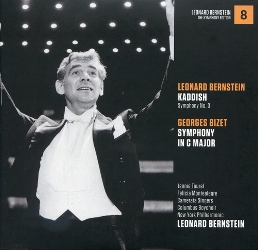Leonard Bernstein - Symphony no 3 Kaddish & Georges Bizet - Symphony in C Major
Leonard Bernstein - Symphony no 3 Kaddish & Georges Bizet - Symphony in C Major (2011)

Kaddish - Symphony No. 3 For Soprano, Speaker, Boys' Choir, Mixed Chorus And Orchestra 1 I Invocation. Adagio - Kaddish 1. L'istesso Tempo - Allegro Molto 8:23 play 2 II Din-Torah. Di Nuovo Adagio - Kaddish 2. Andante Con Tenerezza 16:00 3 III Kaddish 3. Scherzo. Presto Scherzando, Sempre Pianissimo - Finale. Adagio Come Nel Din-Torah - Allegro Vivo, Con Gioia 18:31 Symphony In C Major 4 I Allegro Vivo 7:03 5 II Adagio 9:20 6 III Scherzo. Allegro Vivace 5:21 play 7 IV Finale. Allegro Vivace 6:07 Jennie Tourel – mezzo-soprano Camerata Singers New York Philharmonic Leonard Bernstein – conductor Recorded at Manhattan Center, New York City, USA , Tracks 1 to 3: 1964 , Tracks 4 to 7: 1963.
Kaddish is Leonard Bernstein's third symphony. The 1963 symphony is a dramatic work written for a large orchestra, a full choir, a boys' choir, a soprano soloist and a narrator. The name of the piece, Kaddish, refers to the Jewish prayer that is chanted at every synagogue service for the dead but never mentions "death."
The symphony is dedicated to the memory of John F. Kennedy who was assassinated on November 22, 1963, just weeks before the first performance of the symphony. Some see the symphony as a reaction to the Holocaust, in part because of the narration and dedication recently added by Samuel Pisar, in memory of Leonard Bernstein. The text Pisar added was about his personal experiences and how his family suffered and perished in the Holocaust.
The Symphony in C is an early work by the French composer Georges Bizet. According to Grove's Dictionary, the symphony "reveals an extraordinarily accomplished talent for an 17-year-old student, in melodic invention, thematic handling and orchestration." Bizet started work on the symphony on 29 October 1855, four days after turning 17, and finished it roughly a month later. It was written while he was studying at the Paris Conservatoire under the composer Charles Gounod, and was evidently a student assignment. Bizet showed no apparent interest in having it performed or published, and while he used certain material from the symphony in later works, the piece was never played in his lifetime. There is no mention of the work in Bizet's letters, and it was unknown to his earlier biographers. His widow, Geneviève Halévy (1849–1926), gave the manuscript to Reynaldo Hahn, who left it along with other papers to the archives of the conservatory library, where it was found in 1933 by Jean Chantavoine. Soon thereafter, Bizet's first British biographer Douglas Charles Parker (1885–1970) showed the manuscript to the conductor Felix Weingartner, who led the first performance in Basel, Switzerland on 26 February 1935.
The symphony was immediately hailed as a youthful masterpiece on a par with Felix Mendelssohn's overture to A Midsummer Night's Dream, written at about the same age, and quickly became part of the standard Romantic repertoire. It received its first recording on 26 November 1937, by the London Philharmonic Orchestra under Walter Goehr.
download: uploaded anonfiles mega 4shared mixturecloud yandex mediafire ziddu
Last Updated (Monday, 26 August 2013 13:00)
